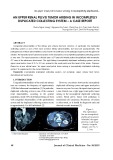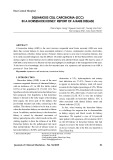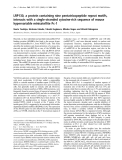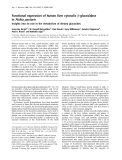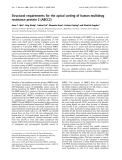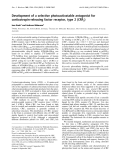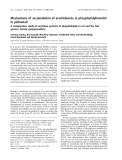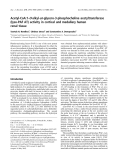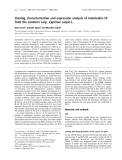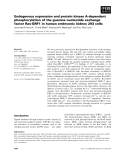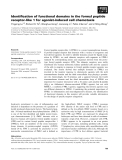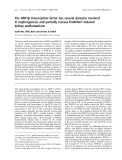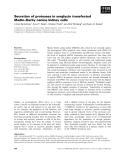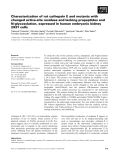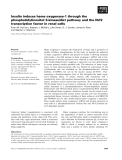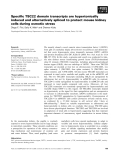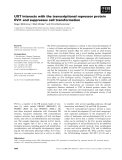
Kidney cells
-
Congenital abnormalities of the kidney and urinary tract are common. In particular, the duplicated collecting system is one of the most common kidney abnormalities, but most are asymptomatic. The pathogenesis of these abnormalities is also known very little and some pathogenic genes are thought to be related.
 5p
5p  vinatisu
vinatisu
 29-08-2024
29-08-2024
 2
2
 1
1
 Download
Download
-
We report a case of HSK with a renal tumour in a 65-year-old man and highlight our challenges in the management of the case. To the best of our knowledge, this is the first reported case of a squamous cell carcinoma in an HSK in province of Thua Thien Hue.
 5p
5p  vinatisu
vinatisu
 29-08-2024
29-08-2024
 7
7
 1
1
 Download
Download
-
Recently, we have identified and purified minisatellite DNA binding proteins (MNBPs) that bind to the mouse hypervariable minisatellite Pc-1, from NIH3T3 cells. This study describes the isolation and characterization of a mouse leucine-rich protein (mLRP130) as one of the MNBPs that binds to the C-rich strand of Pc-1. The mLRP130 cDNA was demonstrated to encode a polypeptide of 1306 aminoacid residues with a deduced molecular mass of 137 kDa, and the mLRP130 mRNA is detected in various organs, including heart, brain, liver, skeletal muscle, kidneys and testes.
 7p
7p  system191
system191
 01-06-2013
01-06-2013
 25
25
 4
4
 Download
Download
-
Human tissues such as liver, small intestine, spleen and kidney contain a cytosolic b-glucosidase (CBG) that hydrolyses variousb-D-glycosides, but whose physiological function is not known. Here, we describe the ®rst hetero-logous expression of human CBG, a system that facili-tated a detailed assessment of the enzyme speci®city towards dietary glycosides.
 10p
10p  research12
research12
 29-04-2013
29-04-2013
 47
47
 3
3
 Download
Download
-
The human multidrug resistance protein 2 (MRP2, symbol ABCC2) is a polytopic membrane glycoprotein of 1545 amino acids which exports anionic conjugates across the apical membrane of polarized cells. A chimeric protein composed of C-proximal MRP2 and N-proximal MRP1 localized to the apicalmembraneof polarizedMadin±Darby canine kidney cells (MDCKII) indicating involvement of the carboxy-proximal part of human MRP2 in apical sorting.
 11p
11p  research12
research12
 23-04-2013
23-04-2013
 31
31
 2
2
 Download
Download
-
Anovel photoactivatable analog of antisauvagine-30 (aSvg-30), a specific antagonist for corticotropin-releasing factor (CRF) receptor, type 2 (CRF2), has been synthesized and characterized. TheN-terminal amino-acidD-Phe in aSvg-30 [D-Phe11,His12]Svg(11)40) was replacedbyaphenyldiazirine, the 4-(1-azi-2,2,2-trifluoroethyl)benzoyl (ATB) residue.
 7p
7p  tumor12
tumor12
 22-04-2013
22-04-2013
 31
31
 3
3
 Download
Download
-
It is known that phosphatidylinositol (PtdIns) contains abundant arachidonate and is composed mainly of 1-stea-royl-2-arachidonoyl species in mammals. We investigated if this characteristic of PtdIns applies to the PtdIns from yellowtail (Seriolaquinqueradiata),amarinefish. Incommon with phosphatidylcholine (PtdCho),phosphatidylethanol-amine (PtdEtn) andphosphatidylserine (PtdSer) frombrain, heart,liver,spleen,kidney and ovary,the predominant polyunsaturated fatty acid was docosahexaenoic acid,and levels of arachidonic acid were less than 4.5% (PtdCho), 7.5%(PtdEtn) and3.
 8p
8p  tumor12
tumor12
 20-04-2013
20-04-2013
 33
33
 3
3
 Download
Download
-
Platelet-activating factor (PAF) is one of the most potent inflammatory mediators. It is biosynthesized by either the de novobiosynthesis of glyceryl ether lipids or by remodeling ofmembranephospholipids. PAFis synthesizedandcatabo-lizedbyvarious renal cells andtissues andexerts awide range of biological activities on renal tissue suggesting a potential role during renal injury.
 9p
9p  fptmusic
fptmusic
 16-04-2013
16-04-2013
 50
50
 4
4
 Download
Download
-
Interleukin (IL)-10 was cloned from the common carp (Cyprinus carpioL.) using IL-10 primers from carp head kidney following stimulation with concanavalin A and lipopolysaccharide. The cDNA consisted of a 1096 bp se-quence containing a 55 bp 5¢ untranslated region and a 498 bp 3¢ untranslated region. An open reading frame of 543 bp encoded a putative 180 amino acid protein with a putative signal peptide of 22 amino acids.
 8p
8p  fptmusic
fptmusic
 12-04-2013
12-04-2013
 31
31
 3
3
 Download
Download
-
We have previously reported the Ras-dependent activation of the mitogen-activated protein kinases p44 and p42, also termed extracellular signal-regulated kinases (ERK)1 and 2 (ERK1⁄2), mediated through Gs-coupled serotonin receptors transiently expressed in human embryonic kidney (HEK) 293 cells. Whereas G i- and Gq-coupled receptors have been shown to activate Ras through the guanine nucleotide exchange factor (GEF) called Ras-GRF1 (CDC25 Mm ) by binding of Ca 2+ ⁄calmodulin to its N-terminal IQ domain, ...
 0p
0p  awards
awards
 06-04-2013
06-04-2013
 35
35
 3
3
 Download
Download
-
Formyl peptide receptor-like 1 (FPRL1) is a seven transmembrane domain, G protein-coupled receptor that interacts with a variety of exogenous and host-derived agonists. In order to identify domains crucial for ligand recog-nition by FPRL1, we used chimeric receptors with segments in FPRL1 replaced by corresponding amino acid sequences derived from the proto-type formyl peptide receptor FPR. The chimeric receptors were stably transfected into human embryonic kidney epithelial cells and the capacity of the cells to migrate in response to formyl peptide receptor agonists was evaluated. ...
 10p
10p  awards
awards
 05-04-2013
05-04-2013
 35
35
 3
3
 Download
Download
-
Signal transduction pathways are often embedded in com-plex networks, which result from interactions between pathways and feedback circuitry. In order to understand such networks, qualitative information on which inter-actions take place and quantitative data on their strength become essential.
 9p
9p  awards
awards
 05-04-2013
05-04-2013
 45
45
 5
5
 Download
Download
-
The tissue-specific transcription factorsHNF1aandHNF1b are closely related homeodomain proteins conserved in vertebrate evolution. Heterozygous mutations in human HNF1b 1 but not inHNF1agenes are associated with kidney malformations. Overexpression of HNF1b in Xenopus embryos leads to defective pronephros development, while HNF1ahas no effect. We have defined the regions respon-sible for this functional difference between HNF1band HNF1ain transfected HeLa cells as well as in injected Xenopusembryos. ...
 14p
14p  awards
awards
 05-04-2013
05-04-2013
 44
44
 3
3
 Download
Download
-
Madin–Darby canine kidney (MDCK) cells, which do not normally express the proteoglycan (PG) serglycin, were stably transfected with cDNA for human serglycin fused to a polyhistidine tag (His-tag). Clones with differ-ent levels of serglycin mRNA expression were generated. One clone with lower and one with higher serglycin mRNA expression were selected for this study.
 12p
12p  dell39
dell39
 27-03-2013
27-03-2013
 41
41
 4
4
 Download
Download
-
To study the roles of the catalytic activity, propeptide, and N-glycosylation of the intracellular aspartic proteinase cathepsin E in biosynthesis, process-ing, and intracellular trafficking, we constructed various rat cathepsin E mutants in which active-site Asp residues were changed to Ala or which lacked propeptides and N-glycosylation.
 11p
11p  dell39
dell39
 27-03-2013
27-03-2013
 50
50
 3
3
 Download
Download
-
Heme oxygenase-1 catalyzes the breakdown of heme and is protective in models of kidney transplantation. In this study we describe the induction of heme oxygenase-1 mRNA and protein by insulin. Following treatment with insulin, a five-fold increase in heme oxygenase-1 mRNA and a four-fold increase in protein expression were observed in renal adenocarcinoma cells; insulin-induced heme oxygenase-1 expression was also demonstrated in mouse primary tubular epithelial cells.
 12p
12p  inspiron33
inspiron33
 26-03-2013
26-03-2013
 57
57
 4
4
 Download
Download
-
Urinary glycoproteins are important inhibitors of calcium oxalate crystal-lization and adhesion of crystals to renal cells, both of which are key mech-anisms in kidney stone formation. This has been attributed to glycosylation of the proteins. In South Africa, the black population rarely form stones (incidence
 14p
14p  inspiron33
inspiron33
 25-03-2013
25-03-2013
 30
30
 3
3
 Download
Download
-
TRPP2, also called polycystin-2, the gene product ofPKD2, is a membrane protein defective in 10–15% of cases of autosomal dominant polycystic kidney disease. Mutations in PKD2 are also associated with extrarenal dis-orders, such as hepatic cystogenesis and cardiovascular abnormalities.
 9p
9p  inspiron33
inspiron33
 23-03-2013
23-03-2013
 35
35
 4
4
 Download
Download
-
We recently cloned a novel osmotic stress transcription factor 1 (OSTF1) from gills of euryhaline tilapia (Oreochromis mossambicus) and demonstra-ted that acute hyperosmotic stress transiently increases OSTF1 mRNA and protein abundance [Fiol DF, Ku¨ltz D (2005) Proc Natl Acad Sci USA 102, 927–932].
 16p
16p  inspiron33
inspiron33
 23-03-2013
23-03-2013
 33
33
 2
2
 Download
Download
-
The EVI1 transcriptional repressor is critical to the normal development of a variety of tissues and participates in the progression of acute myeloid leu-kaemias. The repressor domain (Rp) was used to screen an adult human kidney yeast two-hybrid library and a novel binding partner designated ubiquitously expressed transcript (UXT) was isolated.
 12p
12p  galaxyss3
galaxyss3
 21-03-2013
21-03-2013
 40
40
 5
5
 Download
Download
CHỦ ĐỀ BẠN MUỐN TÌM









